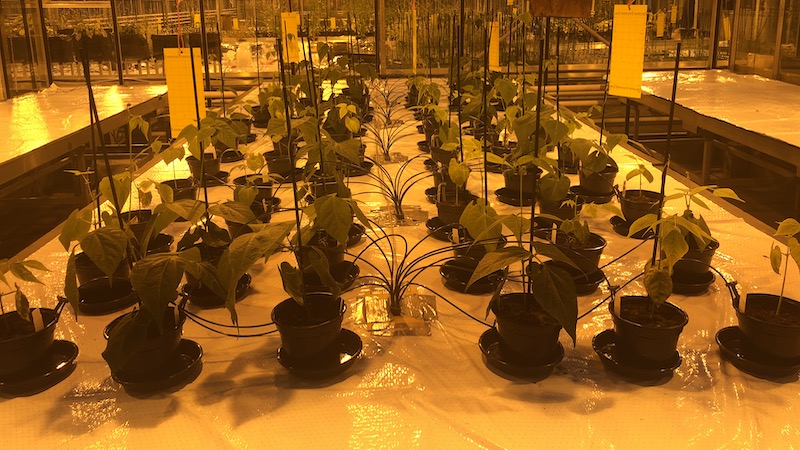Human Urine Boosts Green Bean Growth On Moon And Mars Regolith Simulants
Human Urine Boosts Green Bean Growth On Moon And Mars Regolith Simulants Eurasia Review


Sustainable Agriculture on Mars and the Moon

Living and working on the Moon or planet Mars is a dream for many. However, the challenge lies in ensuring a sustainable agricultural ecosystem to produce food for the inhabitants. A research team at Wageningen University & Research and the B.A.S.E. project is investigating how to grow crops in a circular and sustainable way using local resources. Their latest study focuses on the use of human urine, in the form of struvite, to boost green bean growth on Mars and Moon regolith simulants.
Struvite as Manure
The study conducted by Wieger Wamelink, the principal investigator, utilized struvite extracted from human urine instead of using urine directly. Struvite is a mineral composed of magnesium ammonium and phosphate, which is almost 100% pure and free from contaminants such as medicine residues or drugs. The slow release of nutrients from struvite throughout the growth period proved to be beneficial for plant growth.
Lack of Nutrients in Regolith Simulants
Real Mars and Moon regoliths were not available for the experiments; therefore, the research team used regolith simulants. Both the real regoliths and their simulants lack essential nutrients like ammonium, nitrate, and phosphate required for proper plant growth.
Wamelink states, “We have proven that struvite can be an excellent manure. By processing and applying human urine as fertilizer in the regoliths, we can boost plant growth and significantly increase bean harvest on the regolith simulants.”
Contamination and Future Research
Although the green beans were not tasted or consumed due to the unavailability of official approval for using struvite as a manure, further research is required to assess the contamination of crops with heavy metals from the regolith.
The Golden Circle of Crop Growth
To enable crop growth on Mars and the Moon, a closed and sustainable agricultural ecosystem is necessary. Since these celestial bodies lack organic matter, the soils need to be amended and improved. One crucial aspect of this system is the recycling of human waste.
Wamelink explains, “By applying struvite extracted from human urine, we can fill in one of the steps in the golden circle of crop growth on Mars and the Moon, as well as here on Earth. Human urine could be used as fertilizer instead of being wasted.”
The B.A.S.E. Project
The B.A.S.E. project aims to establish a Moon/Mars dome that replicates the necessary conditions for growing crops indoors. This research facility will test innovations and integrate them into a circular system. The blueprint developed for Mars and the Moon can also be applied in other extreme environments on Earth, such as deserts or the South Pole.
The Food for Mars and Moon Project
The Food for Mars and Moon project focuses on growing crops using available resources like regolith and ice. The research team has successfully grown various crops, including potatoes, carrots, peas, tomatoes, garden cress, and radishes on regolith simulants. The project is now working towards achieving full circularity in crop production by incorporating pollinators, bacteria, fungi, and earthworms.
SDGs, Targets, and Indicators
-
SDG 2: Zero Hunger
- Target 2.3: By 2030, double the agricultural productivity and incomes of small-scale food producers, in particular women, indigenous peoples, family farmers, pastoralists, and fishers, including through secure and equal access to land, other productive resources and inputs, knowledge, financial services, markets, and opportunities for value addition and non-farm employment.
- Indicator 2.3.1: Volume of production per labor unit by classes of farming/pastoral/forestry enterprise size
-
SDG 6: Clean Water and Sanitation
- Target 6.3: By 2030, improve water quality by reducing pollution, eliminating dumping and minimizing release of hazardous chemicals and materials, halving the proportion of untreated wastewater and substantially increasing recycling and safe reuse globally.
- Indicator 6.3.2: Proportion of bodies of water with good ambient water quality
-
SDG 12: Responsible Consumption and Production
- Target 12.4: By 2020, achieve the environmentally sound management of chemicals and all wastes throughout their life cycle, in accordance with agreed international frameworks, and significantly reduce their release to air, water and soil in order to minimize their adverse impacts on human health and the environment.
- Indicator 12.4.2: Hazardous waste generated per capita and proportion of hazardous waste treated, by type of treatment
-
SDG 15: Life on Land
- Target 15.3: By 2030, combat desertification, restore degraded land and soil, including land affected by desertification, drought and floods, and strive to achieve a land degradation-neutral world.
- Indicator 15.3.1: Proportion of land that is degraded over total land area
Table: SDGs, Targets, and Indicators
| SDGs | Targets | Indicators |
|---|---|---|
| SDG 2: Zero Hunger | Target 2.3: By 2030, double the agricultural productivity and incomes of small-scale food producers, in particular women, indigenous peoples, family farmers, pastoralists, and fishers, including through secure and equal access to land, other productive resources and inputs, knowledge, financial services, markets, and opportunities for value addition and non-farm employment. | Indicator 2.3.1: Volume of production per labor unit by classes of farming/pastoral/forestry enterprise size |
| SDG 6: Clean Water and Sanitation | Target 6.3: By 2030, improve water quality by reducing pollution, eliminating dumping and minimizing release of hazardous chemicals and materials, halving the proportion of untreated wastewater and substantially increasing recycling and safe reuse globally. | Indicator 6.3.2: Proportion of bodies of water with good ambient water quality |
| SDG 12: Responsible Consumption and Production | Target 12.4: By 2020, achieve the environmentally sound management of chemicals and all wastes throughout their life cycle, in accordance with agreed international frameworks, and significantly reduce their release to air, water and soil in order to minimize their adverse impacts on human health and the environment. | Indicator 12.4.2: Hazardous waste generated per capita and proportion of hazardous waste treated, by type of treatment |
| SDG 15: Life on Land | Target 15.3: By 2030, combat desertification, restore degraded land and soil, including land affected by desertification, drought and floods, and strive to achieve a land degradation-neutral world. | Indicator 15.3.1: Proportion of land that is degraded over total land area |
Analysis
1. Which SDGs are addressed or connected to the issues highlighted in the article?
The SDGs addressed or connected to the issues highlighted in the article are SDG 2: Zero Hunger, SDG 6: Clean Water and Sanitation, SDG 12: Responsible Consumption and Production, and SDG 15: Life on Land.
2. What specific targets under those SDGs can be identified based on the article’s content?
Based on the article’s content, the specific targets under the identified SDGs are:
– Target 2.3: By 2030, double the agricultural productivity and incomes of small-scale food producers.
– Target 6.3: By 2030, improve water quality by reducing pollution and minimizing release of hazardous chemicals and materials.
– Target 12.4: By 2020, achieve the environmentally sound management of chemicals and all wastes throughout their life cycle.
– Target 15.3: By 2030, combat desertification, restore degraded land and soil, and strive to achieve a land degradation-neutral world.
3. Are there any indicators mentioned or implied in the article that can be used to measure progress towards the identified targets?
Yes, there are indicators mentioned or implied in the article that can be used to measure progress towards the identified targets:
– Indicator 2.3.1: Volume of production per labor unit by classes of farming/pastoral/forestry enterprise size.
– Indicator 6.3.2: Proportion of bodies of water with good ambient water quality.
– Indicator 12.4.2: Hazardous waste generated per capita and proportion of hazardous waste treated, by type of treatment.
– Indicator 15.3.1: Proportion of land that is degraded over total land area.
These indicators can be used to measure the progress made in achieving the targets related to agricultural productivity, water quality improvement, waste management, and land restoration.
By implementing sustainable agricultural practices using local resources like struvite extracted from human urine, progress can be measured in terms of increased crop production per labor unit (Indicator 2.3.1), improved water quality through reduced pollution
Behold! This splendid article springs forth from the wellspring of knowledge, shaped by a wondrous proprietary AI technology that delved into a vast ocean of data, illuminating the path towards the Sustainable Development Goals. Remember that all rights are reserved by SDG Investors LLC, empowering us to champion progress together.
Source: eurasiareview.com

Join us, as fellow seekers of change, on a transformative journey at https://sdgtalks.ai/welcome, where you can become a member and actively contribute to shaping a brighter future.







